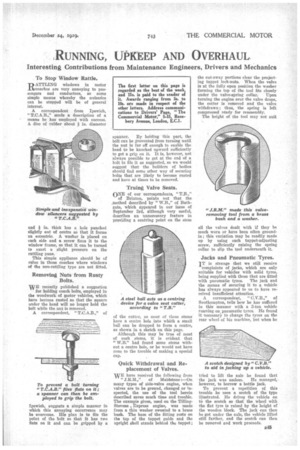,RUNNING, UPKEEP AND OVERHAUL
Page 63

If you've noticed an error in this article please click here to report it so we can fix it.
Interesting Contributions from Maintenance Engineers, Drivers and Mechanics
To Stop Window Rattle.
RATTLING windows in motor coaches are very annoying to passengers and conductors, so some simple means whereby the nuisance can be stopped will be of general interest.
A correspondent from Ipswich, " T.C.A.B.," sends a description of a means he has employed with success. A disc of rubber about r in. diameter and in, thick has a hole punched
slightly out of centre so that it forms an eccentric. A washer is placed on each aide and a screw fixes it to the window frame, so that it can be turned to exert a slight pressure on the rattling pane.
This simple appliance should be of value in those coaches where windows of the non-rattling type are not fitted.
Removing Nuts from Rusty Bolts.
ivE recently published a suggestion
for holding coach bolts, employed in the woodwork of motor vehicles, which have become rusted so that the square under the head will no longer hold the bolt while the nut is removed.
A correspondent, "T.C.A.B.," of
Ipswich, suggests a simple manner in which this annoying occurrence may be overcome. Eke plan is to file the point of the bolt so that it has two flats on it and can be gripped by a
spanner. By holding this part, the
bolt can be prevented from turning until the nut is far off enough to enable the head to be knocked upward sufficiently to get a grip on it. It is, however, not always possible to get at the end of a bolt to file it as suggested, so we would suggest that the builders of bodies should find some other way of securing bolts that are likely to become rusted and have at times to be removed.
Truing Valve Seats.
ONE of our correspondents, " T.B.," of Brixton, points out that the ,method described by " W.B.," of Bathgate, which appeared in our issue of September 3rd, although very useful, describes an unnecessary feature in providing a centring point on the stem of the cutter, as most of these stems have a centre hole into whieh a small ball can be dropped to form a centre, as shown in a sketch on this page. Although this may be true of most of such stems, it is evident that " W.B." had found some stems without a centre hole, or he would not have gone to the trouble of making a special cap.
Quick Withdrawal and Replacement of Valves.
WE have received the following from " J.R.M.," of Maidstone :—On many types of side-valve engine, when valves are to be ground, changed or inspected, the use of the tool herein described saves much time and trouble. The example given, used on the TillingStevens Express engine, was made from a thin washer sweated to a brass bush. The base of the fitting rests on the top of the tappet guide and the upright shell stands behind the tappet; the cut-away portions clear the projecting tappet loek-nuts. When the valve lest the fully open position the washer forming the top of the tool fits closely
under the valve-spring collar. Upon taming the engine over the valve drops, the cotter is removed and the valve withdrawn ; thus, the spring is left !compressed ready for reassembly.
The height of the tool may not suit all the valves dealt with if they be much worn or have been often groundin ; this variation may be readily made up by using each tappet-adjusting strew, sufficiently raising the spring collar to slip the tool underneath it.
Jacks and Pneumatic Tyres.
IT is strange that we still receive
complaints of jacks, which are only suitable for vehicles with solid tyres, being supplied with those that are fitted with pneumatic tyres. The jack and the means of securing it to a vehicle has always appeared to us to have received insufficient attention.
A correspondent, " C.V.B.," of Southampton, tells how he has suffered in this manner with a 3-ton vehicle running on pneumatic tyres. He found it necessary to change the tyres on the rear wheel of his machine, but when he
tried to lift the axle he found that the jack was useless. He managed, however, to borrow a bottle jack.
To prevent a repetition of this trouble he uses a scotch of the type illustrated. Ile drives the vehicle on to the scotch so that the wheel with the flat tyre is raised by the height of the wooden block. The jack can then be got under the axle, the vehicle lifted still farther, and the scotch can then be removed and work proceeds.




































































































